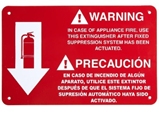Overview
Be safe from fire in the kitchen by following the guidance on this page.
Cooking in UCSF Housing
Whether you are a veteran chef or a newcomer to the culinary arts, there are several steps you should take to ensure the safety of yourself and your peers when cooking.
- Clear the cooking/preparation area of anything that can burn (paper, fabrics, cardboard, etc.)
- Ensure that any children or pets are no less than three feet away from the stove/oven.
- Try to wear short or close-fitting sleeves that are at low risk of snagging or getting burnt.
- Check the cleanliness of your cleaning surfaces to ensure that there is no food or grease build-up.
While Cooking
- Keep an eye on your cooking and stay in the kitchen! Unattended cooking is the #1 cause of cooking-related fires.
- Turn pot handles toward the back of the stove (away from you) so that no one can bump into them or pull them over.
- Keep a pan lid or baking sheet nearby so that you can 'suffocate' any small fires that occur by covering the cooking surface.
- Whenever you are unsure if you can properly smother a cooking-related fire, alert all residents of your home and get out closing the door behind you. Then call 9-1-1.
- Use oven mitts to move hot pots, pans, and baking sheets to avoid burns and spills.
Print out or use the following to share with your loved ones! Serving Up Safety! Preventing Kitchen Fires
Commercial Cooking Operations
UCSF Fire Prevention wants to ensure that all commercial cooking operations in UCSF facilities follow these three best practices – preventative maintenance, good housekeeping, and employee training. Following all of these helps ensure a significantly reduced fire risk for everyone!
Maintenance: California Fire Code requires commercial kitchen hoods and their associated fire suppression systems to be inspected, tested and maintained, and are subject to inspection by UCSF Fire Prevention.
Inspection, testing and maintenance of the following:
Grease Cleaning: Hoods, fans, ducts, and other appurtenances shall be inspected and cleaned of accumulated grease at a minimum of every 6 months. This interval is to be increased to every 3 months for vendors with high-volume cooking operations such as 24-hour cooking, charbroiling or wok cooking.
Service Tags: Whenever a commercial kitchen hood is inspected a tag containing the service provider name, address, telephone number and date of service shall be provider in a conspicuous location.
 Service Tag
Service Tag
Records of System Service: Office of the State Fire Marshal form AES 20 shall be used to record the results of testing and maintenance and shall be kept on the premises.
Class K Fire Extinguishers: Class K fire extinguishers shall be provided for hazards where there is a potential for fires involving combustible cooking media (vegetable or animal oils and fats). Fire extinguisher shall be mounted no higher than 4 feet and no farther than 30 feet from the hazard.
Placard: A placard shall be conspicuously placed near the extinguisher that states that the fire protection system shall be activated prior to using the fire extinguisher.
 Placard
Placard
To avoid building fire alarm activation, all inspection, testing and maintenance must be done in coordination with UCSF Campus Facilities Management at (415) 476 - 2021 or UCSF Health Facilities at (415) 514-3570.
Housekeeping
Clean your kitchen regularly. This is one of the simplest but most important best practices you can implement in your kitchen. Staff should regularly clean grease on walls, work surfaces, ranges, fryers, broilers, grills and convection ovens. Grease traps need be cleaned regularly to prevent them from overflowing and reduce the risk of fire. Create checklists to ensure daily, weekly, and monthly cleaning activities are completed.
- Reduce storage of combustible materials, and remove debris, including boxes and pallets, as soon as possible.
- Maintain clear evacuation routes through your facility and don’t block fire extinguishers with carts, boxes or other storage.
Employee Training
Are your employees properly trained to respond to a commercial kitchen fire and do they know how to use a fire extinguisher?
UCSF Fire Prevention can train your employees on how to use a fire extinguisher, how the suppression system works, and what to do if a fire does break out.
Please use the following Cooking Up Safety Commercial Operations for review with your employees and post on a staff safety bulletin board.
